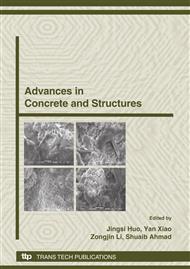p.873
p.881
p.887
p.893
p.901
p.911
p.917
p.923
p.929
Investigation of the Axial Bearing Capacity of the Discontinuous-Tube-in-Core Concrete Filled Steel Tubular Column-Slab Joint
Abstract:
Based on the principle of restrained concrete, this paper presents a new-type concrete filled steel tubular column-slab joint. This new-type joint is characterized by keeping the concrete floor slab continuous while breaking the steel tube of the column for the joint, thus joining the slab and the concrete filled steel tubular(CFST) columns at the top and the bottom of the slab. The joint has the advantage of transferring loads dependably, constructing conveniently and saving on the cost. Three groups of experiments (21 specimens contained) were performed to test the safety of the joint and investigate its axial bearing capacity. The results show that the joint is dependable and feasible in engineering applications. In addition, this paper studies the working mechanism and mechanical properties of the joint under axial compression, discusses the factors to influence its axial bearing capacity, and finally brings out the formula of the joint’s bearing capacity under axial compression that adapts to engineering applications, which conservatively evaluate the result of the experiments.
Info:
Periodical:
Pages:
901-910
Citation:
Online since:
October 2008
Authors:
Price:
Сopyright:
© 2009 Trans Tech Publications Ltd. All Rights Reserved
Share:
Citation:


